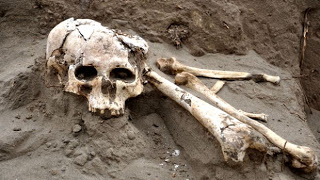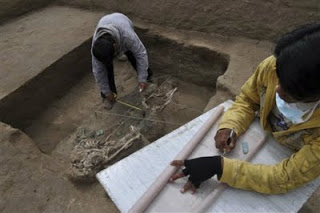Arqueologia
FoxNews.com
 AP Photo/Violeta Ayasta July 15, 2011: A skull and bones sit on a pre-hispanic tomb recently discovered in Lambayeque, northern Peru. According to Carlos Wester, chief of the team of archaeologists who discovered the tomb, it belongs to a top lord of the Lambayeque culture, believed to have been an executioner.
AP Photo/Violeta Ayasta July 15, 2011: A skull and bones sit on a pre-hispanic tomb recently discovered in Lambayeque, northern Peru. According to Carlos Wester, chief of the team of archaeologists who discovered the tomb, it belongs to a top lord of the Lambayeque culture, believed to have been an executioner.
Archaeologists in Peru have discovered the tomb of a lord of the Lambayeque culture, believed to have been an executioner due to the three ceremonial knives found buried with him.
Near the pre-Hispanic tomb were human remains, as well as ceremonial knives, ceramic pots, a dress made from native cotton and a series of rolled copper discs, said Carlos Wester, director of the Bruning Museum in Lambayeque and one of the tomb's discoverers.
Wester told AFP the person buried there was most likely in charge of human sacrifice.
"We found the perfectly preserved tomb of a sacrificer of the Lambayeque culture, with copper machetes and human offerings laid around them," Wester told the news agency.
The tomb was found in a place called "ceremonial fertility and water," two weeks ago in the archaeological complex Chotuna Chornancap, a thousand-year-old temple complex discovered in January 2010.
The 20 to 30 year old resident of the tomb "played an important role in the ceremonies of human sacrifice" for the ancient culture, which flourished from 700 to 1375 AD. Sicán or Lambayeque culture emerged around the eighth century, lasted until 1375 and peaked between 900 and 1100.
This civilization worshiped the "Lord of Sican"; during the heyday of the culture, there were seven to eight such figures representing the heavenly power on earth.
They were described as wearing masks with winged eyes and pointed ears, the archaeologist said.

Fonte: http://www.foxnews.com/scitech/2011/07/20/ancient-peruvian-tomb-points-to-human-sacrifice/?cmpid=cmty_email_Gigya_Found%3A_Ancient_Peruvian_Executioner's_Lost_Head (20/07/2011)
- Archaeologists Excavate Ancient Wari Temple In Peru
An international team of archaeologists under the joint directorship of Dr. Maria Lozada of the University of Chicago, Dr. Hans Barnard of the Cotsen Institute of Archaeology of UCLA, and Lic. Augusto Cardona Rosas of the Centro de Investigaciones Arqueológicas...
- Mayan Archaeological Sites, Graves Found In Southeastern Mexico
Mexican experts have discovered seven new Mayan archaeological sites and an "important concentration" of pre-Columbian graves in the southeastern state of Yucatan, the National Institute of Anthropology and History, or INAH, said. The vestiges, which...
- More Than 1,000 Year-old Archaeological Pieces From Palenque Studied And Restored
Archaeological pieces created more than 1000 years ago, found at the ancient city of Palenque, Chiapas, such as the tableau of the Temple of the Cross (Templo de la Cruz), the mask of the Red Queen (Reina Roja) and a group of figurines that represent...
- Zapoteca And Mixteca Art Together For The First Time At The National Museum Of Anthropology
Foto: Burial ceremony at Monte Alban. Photo: DMC INAH/M. Tapia. MEXICO CITY.- The Bat God Mask, golden objects from Tomb 7 in Monte Alban, Atzompa ceremonial vases, and the model of a mortuary rite, are part of the great exhibition Six Ancient Cities...
- 37 Pre-inca Tombs Discovered In Southern Peru
The human remains found last week are currently in custody of Tacna's regional cultural agency. (Photo: Ernesto Suárez/El Comercio) Thirty-seven pre-Inca tombs, which date back to between 800 and 1445 AD, were accidentally discovered last week while...
Arqueologia
Found: Ancient Peruvian Executioner's Lost Head
FoxNews.com
 AP Photo/Violeta Ayasta July 15, 2011: A skull and bones sit on a pre-hispanic tomb recently discovered in Lambayeque, northern Peru. According to Carlos Wester, chief of the team of archaeologists who discovered the tomb, it belongs to a top lord of the Lambayeque culture, believed to have been an executioner.
AP Photo/Violeta Ayasta July 15, 2011: A skull and bones sit on a pre-hispanic tomb recently discovered in Lambayeque, northern Peru. According to Carlos Wester, chief of the team of archaeologists who discovered the tomb, it belongs to a top lord of the Lambayeque culture, believed to have been an executioner.Archaeologists in Peru have discovered the tomb of a lord of the Lambayeque culture, believed to have been an executioner due to the three ceremonial knives found buried with him.
Near the pre-Hispanic tomb were human remains, as well as ceremonial knives, ceramic pots, a dress made from native cotton and a series of rolled copper discs, said Carlos Wester, director of the Bruning Museum in Lambayeque and one of the tomb's discoverers.
Wester told AFP the person buried there was most likely in charge of human sacrifice.
"We found the perfectly preserved tomb of a sacrificer of the Lambayeque culture, with copper machetes and human offerings laid around them," Wester told the news agency.
The tomb was found in a place called "ceremonial fertility and water," two weeks ago in the archaeological complex Chotuna Chornancap, a thousand-year-old temple complex discovered in January 2010.
The 20 to 30 year old resident of the tomb "played an important role in the ceremonies of human sacrifice" for the ancient culture, which flourished from 700 to 1375 AD. Sicán or Lambayeque culture emerged around the eighth century, lasted until 1375 and peaked between 900 and 1100.
This civilization worshiped the "Lord of Sican"; during the heyday of the culture, there were seven to eight such figures representing the heavenly power on earth.
They were described as wearing masks with winged eyes and pointed ears, the archaeologist said.

Fonte: http://www.foxnews.com/scitech/2011/07/20/ancient-peruvian-tomb-points-to-human-sacrifice/?cmpid=cmty_email_Gigya_Found%3A_Ancient_Peruvian_Executioner's_Lost_Head (20/07/2011)
loading...
- Archaeologists Excavate Ancient Wari Temple In Peru
An international team of archaeologists under the joint directorship of Dr. Maria Lozada of the University of Chicago, Dr. Hans Barnard of the Cotsen Institute of Archaeology of UCLA, and Lic. Augusto Cardona Rosas of the Centro de Investigaciones Arqueológicas...
- Mayan Archaeological Sites, Graves Found In Southeastern Mexico
Mexican experts have discovered seven new Mayan archaeological sites and an "important concentration" of pre-Columbian graves in the southeastern state of Yucatan, the National Institute of Anthropology and History, or INAH, said. The vestiges, which...
- More Than 1,000 Year-old Archaeological Pieces From Palenque Studied And Restored
Archaeological pieces created more than 1000 years ago, found at the ancient city of Palenque, Chiapas, such as the tableau of the Temple of the Cross (Templo de la Cruz), the mask of the Red Queen (Reina Roja) and a group of figurines that represent...
- Zapoteca And Mixteca Art Together For The First Time At The National Museum Of Anthropology
Foto: Burial ceremony at Monte Alban. Photo: DMC INAH/M. Tapia. MEXICO CITY.- The Bat God Mask, golden objects from Tomb 7 in Monte Alban, Atzompa ceremonial vases, and the model of a mortuary rite, are part of the great exhibition Six Ancient Cities...
- 37 Pre-inca Tombs Discovered In Southern Peru
The human remains found last week are currently in custody of Tacna's regional cultural agency. (Photo: Ernesto Suárez/El Comercio) Thirty-seven pre-Inca tombs, which date back to between 800 and 1445 AD, were accidentally discovered last week while...
